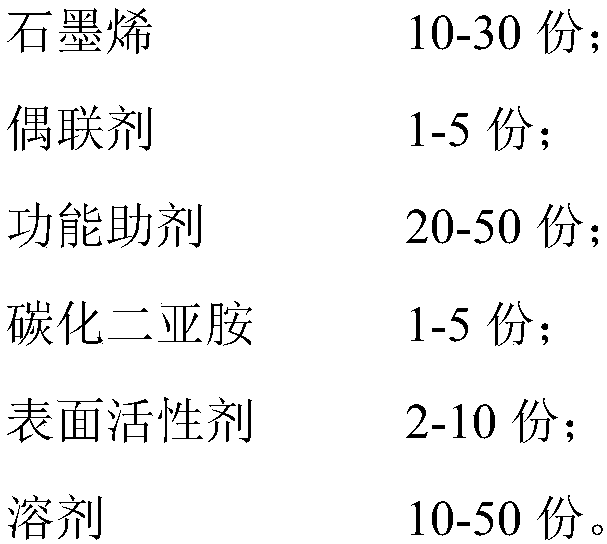Process for preparing polyamide graphene composite material
A composite material and preparation technology, which is applied in the direction of single-component polyamide rayon, rayon manufacturing, conductive/antistatic filament manufacturing, etc., can solve the problems of uncontrolled polyamide water content, complicated operation steps, and product performance. Influence and other issues, to achieve the uniformity of production quality and production stability, improve the dispersion effect, improve the effect of mechanical properties
- Summary
- Abstract
- Description
- Claims
- Application Information
AI Technical Summary
Problems solved by technology
Method used
Image
Examples
Embodiment 1
[0031] (1) Pretreatment: 10 parts of graphene, 20 parts of nano-tourmaline, and 20 parts of nano-silver ions are respectively surface-treated with 1 part of silane coupling agent KH-560;
[0032] (2) Premixing: Mix the graphene treated in step (1) with functional additives, then add 1 part of polycarbodiimide UN-03, 10 parts of Tween 80 and 30 parts of o-toluenesulfonamide, and ultrasonically 50min to obtain the modified mixed solution;
[0033] (3) Melt intercalation polymerization: mix caprolactam and the modified mixed solution obtained in step (2) at a mass ratio of 100:3, react at a temperature of 210°C and a pressure of 0.1MPa for 8 hours, and then extrude and granulate to obtain graphite vinyl / polyamide composites.
Embodiment 2
[0035] (1) Pretreatment: use 1 part of titanate coupling agent TMC-201 and 0.5 parts of silane coupling agent KH with 20 parts of graphene, 30 parts of nano-tourmaline, 10 parts of nano-copper ion and 5 parts of nano-titanium ion respectively -570, 1 part of silane coupling agent KH-550, 1 part of silane coupling agent KH-550 for surface treatment;
[0036] (2) Premixing: Mix the graphene processed in step (1) with functional additives, then add 3 parts of polycarbodiimide K-1, 5 parts of sodium dodecylbenzenesulfonate and 20 parts of ethylene glycol Alcohol ester, ultrasonic 30min, obtain modified mixed solution;
[0037] (3) Melt intercalation polymerization: mix caprolactam and the modified mixed solution obtained in step (2) at a mass ratio of 100:5, react at a temperature of 250°C and a pressure of 0.05MPa for 8 hours, and then extrude and granulate to obtain graphite vinyl / polyamide composites.
Embodiment 3
[0039] (1) Pretreatment: Use 2 parts of titanate coupling agent TMC-TTS, 2 parts of silane coupling agent KH-550, and 1 part of silane respectively with 30 parts of graphene, 8 parts of nano-tourmaline, and 16 parts of nano-copper ions Coupling agent KH-560 for surface treatment;
[0040](2) Premixing: Mix the graphene treated in step (1) with functional additives, then add 5 parts of polycarbodiimide K-1, 5 parts of polyoxyethylene lauryl ether, and 5 parts of polyoxyethylene lauryl ether Alkyl ether, 50 parts of p-toluenesulfonamide and 6 parts of thiourea peroxide, and ultrasonication for 60 minutes to obtain a modified mixed solution;
[0041] (3) Melt intercalation polymerization: mix caprolactam and the modified mixed solution obtained in step (2) at a mass ratio of 100:1, react at a temperature of 240°C for 9 hours under normal pressure, and then extrude and granulate to obtain graphene / polyamide composite.
PUM
 Login to View More
Login to View More Abstract
Description
Claims
Application Information
 Login to View More
Login to View More - R&D
- Intellectual Property
- Life Sciences
- Materials
- Tech Scout
- Unparalleled Data Quality
- Higher Quality Content
- 60% Fewer Hallucinations
Browse by: Latest US Patents, China's latest patents, Technical Efficacy Thesaurus, Application Domain, Technology Topic, Popular Technical Reports.
© 2025 PatSnap. All rights reserved.Legal|Privacy policy|Modern Slavery Act Transparency Statement|Sitemap|About US| Contact US: help@patsnap.com



